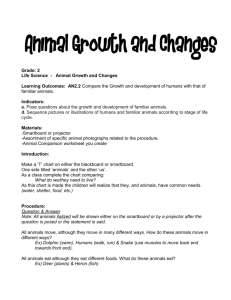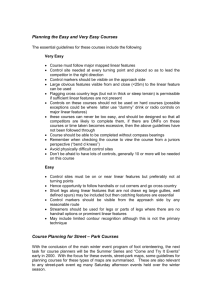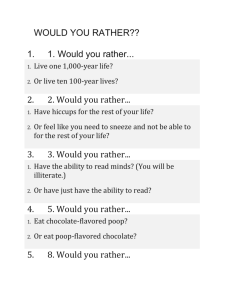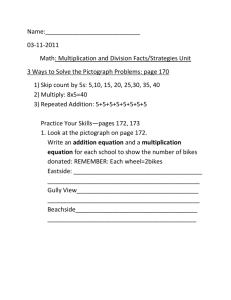And then God created reptiles
advertisement
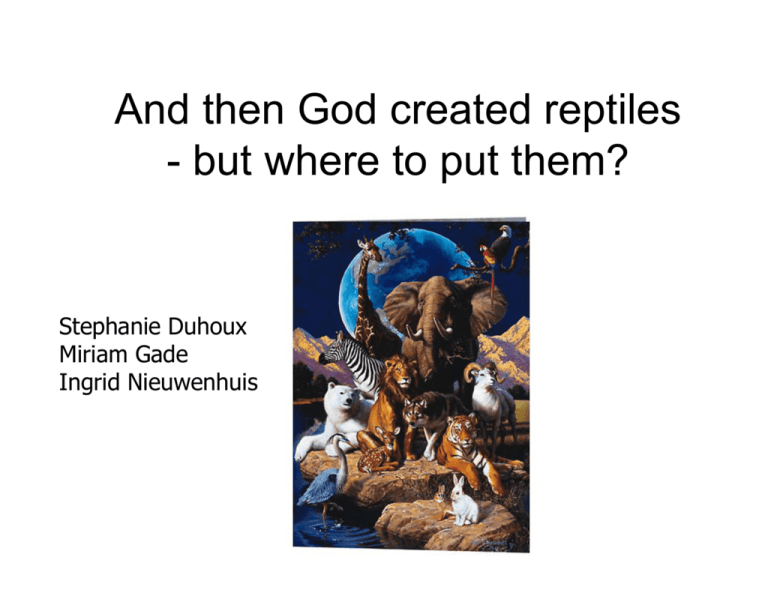
And then God created reptiles - but where to put them? Stephanie Duhoux Miriam Gade Ingrid Nieuwenhuis Visual learning: identification and categorization Representations: Variability and specificity Generalization across variations: Different levels of specificty: Individual level: my cat Categorical level: Basic level: a cat Superordinate level: a mammal Where in the brain? • Monkeys: Inferior temporal cortex: critical role in visual object recognition (Logothetis et al., 1995; Sigala et al., 2001; Tanaka, 1996) • Human: Temporal cortex, sensitive to the categorization level of the stimuli, depend on the level of expertise of the observer (Gauthier et al., 1997; Gauthier et al., 2000). Debate on the processing of the faces and other categories: domain-specificity view, Fusiform Face Area (Kanwisher et al., 1997) expertise view (Gauthier et al., 2003) Other view: the representations of faces and objects in ventral temporal cortex are widely distributed and overlapping. Palmeri, Wong & Gauthier, TICS 2004 Still to be known • How are categories formed and represented in the brain? • Which object features are represented? • How are these representations affected by categorization training? • How does a new category integrate a network of existing category representations? Animal categorization modelling etc Self organizing map (already explained) Inputs red blue yellow walk fly swim eggs milk feathers scales hair 0 legs 2 legs 4 legs 6 legs 8 legs harmful carnivore herbivore omnivore warm blood red red blue blue yellow yellow walk walk fly fly swim swim eggs eggs milk milk feathers feathers scales scales hair hair 0 legs 0 legs 2 legs 2 legs 4 legs 4 legs 6 legs 6 legs 8 legs 8 legs harmfull harmfull carni carni herbi herbi omni omni warm blood warm blood 20 mammals, 20 insects, 20 birds, 20 fish color walks Hair Warm blooded Parameters • Default training: starting with large radius and learning rate which decreases over time red 0.55 blue 0.6 yellow 0.55 walk 0.85 fly 0.05 swim 0.2 eggs 0.05 milk 1.0 feathers 0 scales 0 hair 0.95 0 legs 0.05 2 legs 0.15 4 legs 0.8 6 legs 0 8 legs 0 harmful 0.2 carni 0.2 herbi 0.5 omni 0.3 warm blood 1.0 How to plot? You can calculate the “average” mammal, and look where that is represented on the map And then God created reptiles….. The brain must be flexible and always able to store more; How do we manage to store new items, even whole new categories without messing up what we already know? Catastrophic interference If you present only the new items to the network, the structure of the information that was already stored becomes catastrophically disturbed….. Model • Categorization: – Default training: starting with large radius and learning rate which decreases over time • More biological plausible “brainy”: – Fixed learning rate and radius – Low learning rate (otherwise no stability) and thus very many learning epochs Parameters used • Train model on 4 categories first – Alpha 0.1, 100 trials, radius 5 (cheating) – Alpha 0.05, 10000 trials, radius 4 • Train model on reptiles (and amphibians) – Alpha 0.05, radius 4 • 5, 10, 20, 50 trials Four categories after initial training 5 cycles of only reptile learning 10 cycles of only reptile learning 20 cycles of only reptile learning start 5 10 20 50 start 5 10 20 50 start 5 10 20 50 start 5 10 20 50 start 5 10 20 50 So how does the brain solve this?! • Interleaved learning – The new information is presented to the cortex but the information in the cortex is also activated in between to prevent over-writing of old information Cortex Categorization REM sleep information Slow Wave Sleep Hippocampus Parameters used • Train model on 4 categories first – Alpha 0.1, 100 trials, radius 5 (cheating) – Alpha 0.05, 10000 trials, radius 4 • Train model on all the categories including the reptiles and amphibians – Alpha 0.05, radius 4 • 5, 100, 1000, 10000 trials start 5 100 1000 10000 start 5 100 1000 10000 start 5 100 1000 10000 start 5 100 1000 10000 start 5 100 1000 10000 Thanks for your attention

